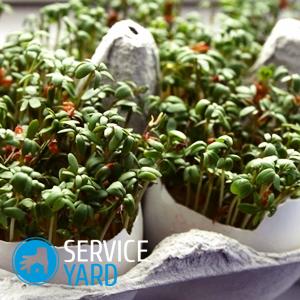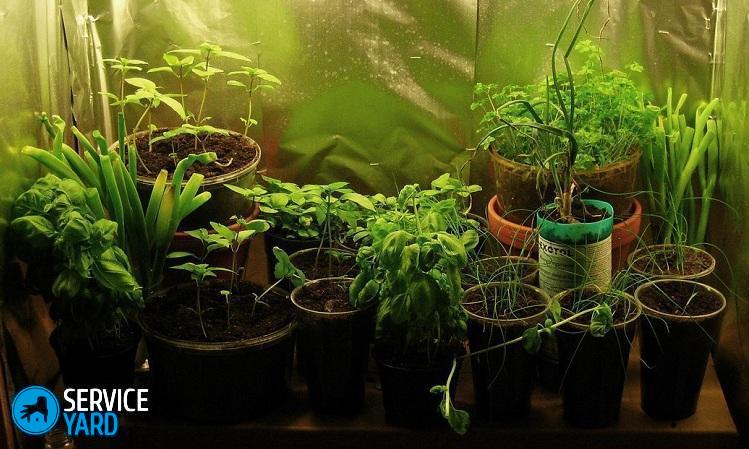Lamps for growing plants at home

Of course, natural lighting is available to everyone, and there is no need to spend money on it, but, unfortunately, it is not always enough. If the plants have little light (this is especially often observed during the winter season), then you have to resort to the use of additional light sources. Special lamps for growing plants at home are designed so that the waves emitted by them stimulate growth and create good conditions for photosynthesis. Consider which device is better to choose for the effective growing of greens at home.
to contents ↑What kind of lighting is needed for growing plants?
Artificial light for growing plants at home should emit a spectrum of electromagnetic radiation similar to that received by plants in a natural environment. If complete similarity is difficult to achieve, then lighting should cover at least minimal needs.
To ensure the most comfortable conditions for growth and development, special lamps are selected that have a different effect. A specific choice should depend on what kind of plant will be grown, at what stage of development it is.
Important! In the process of using artificial light sources, it is imperative that they give assimilation lighting, which is necessary for plant growth. If lamps are ineffective for this purpose, then for the most part they will only produce heat.
To date, several schemes for using artificial lighting can be used:
- To increase the intensity of photosynthesis, artificial light is used as an addition to natural.
- Periodic circuit - additional light is connected in order to be able to control the duration of the light period during the day.
- Full replacement of natural light, which makes it possible to completely control the process of growth and development of plants.
Important! It is worth noting that a complete replacement for natural light can only be used in rooms with controlled climate. Only by observing the balance can the most optimal plant development rate be ensured.
Useful Tips
When deciding to use lamps for growing plants at home, you need to follow some recommendations:
- As a rule, the closer the lamp is placed to the sprout itself, the greater the benefit from it, however, it is worth it to behave very carefully in order to prevent too much heat.
- If the light source is located approximately 20 cm from the flowers, then the effect is usually achieved by distributing approximately 70 watts per square meter of soil.
- When the natural daylight begins to shorten (in winter), it should be artificially lengthened, at least 2 hours.
- The light should be directed directly at the plant itself.
Which lights are better to choose?
When creating lighting for plants, the question arises about lamps for plants - how to choose? Today there are many different devices for creating artificial light, but not all of them are suitable for growing plants.Let's look at the most common types of lamps, which make it possible to ensure active growth and development of fauna at home.
LED bulbs
Thanks to the latest developments, LED sources have become available and can serve their owners for a long time. The choice of many falls precisely on this option due to the following advantages:
- Low heat generated.
- Low power.
- Their use can reduce the rate of evaporation of moisture, which means that the periods between irrigation are increased.
- In one lamp several colors can be combined at once, which means that it can cover several phytoactive areas at the same time.
Important! It is not difficult to make a lamp with such light sources, but buying a powerful device will not work, because there are still difficulties in mass production.
Energy Saving (ESL)
The structure of this bulb is very convenient - it has a built-in inductor, which means all that is needed is to simply screw it into the cartridge. ESL is distinguished by the type of glow:
- Cold spectrum (to accelerate seedling growth).
- Warm spectrum (favorably affects the flowering stage).
- Daily spectrum.
Important! It is the latter option that is recommended to be used as an independent source of artificial lighting for plants.
The main advantages of such lamps are low power consumption and long life (on average up to 15 thousand hours). Such advantages have a material expression - one lamp of this type will last a very long time, which can reduce the cost of acquiring new lamps.
Fluorescent
The main advantage of this type of lamp is that it does not heat up, respectively - these light sources do not affect air temperature, which is very important in the process of growing plants.
Important! When choosing a lamp for growing plants at home, it is desirable to give preference to those varieties of fluorescent light sources in which there are blue rays - they are needed for a more efficient synthesis.
Standard Fluora options for one unit of electric power produce 2 times more light energy in comparison with conventional incandescent lamps and can work without interruption up to 20 thousand hours.
Important! It should be noted profitability and long service life. However, cheaper cold-spectrum lamps will be less effective for growing plants.
Aquarium
In order to grow plants in the aquarium, you also need special lamps for artificial lighting. There are two main types of such devices:
- The lamps in the blue part of the Actinic spectrum can produce radiation that penetrates well through the water column. That is why it is desirable to install such lamps for large aquariums.
- Full-spectrum light sources. The light that they emit is most similar to daylight. That is why it is desirable to install them in those aquariums in which there is no way to ensure the entry of light from the window.
Sodium
As a rule, such lamps are used at later periods of growth (at the reproductive stage). Lamps of this type favorably affect the process of forming flowers and fruits, accelerating it. If you use them for young plants, they will grow faster, but will turn out to be more spreading.
Important! In some cases, due to the nature of the cure, the plant may visually appear pale and unhealthy.
This variety of light sources has high light output and a long service life. They are often used as fragmentary light for greenhouses, when the bulk of the light can come from natural sources.
Metal halide
This light source has high efficiency and is approximately 80% close to natural light.These luminaires are universal, since engineers can change the basic characteristics of the light flux, thereby making them the most suitable for a specific purpose.
Important! This technology has a very important attribute - white light, which provides the most accurate proximity to sunlight.
If this type of lamp is used to illuminate plants, then they will grow lower and more compact. Their appearance will not differ much from those copies that grew on the street.
Important! Useful life is about 20 thousand hours.
Ultraviolet
For the most part, ultraviolet radiation has a negative effect on plant growth. Only useful will be:
- Red - promotes seed germination.
- Blue - helps cell division.
- Violet - it is advisable to use in small quantities.
to contents ↑Important! Common bactericidal types of lamps that emit this ultraviolet are unsuitable for growing plants, as are tanning lamps and black devices (occasionally the latter are used to irradiate parsley and dill to improve palatability). Light is one of the most important factors for the growth and development of plants.
Useful tips for choosing
To choose the right lamp for lighting plants at home, it is advisable to know some of the nuances:
- Yellow rays slow down the growth of stems, so the peak in the yellow part of the spectrum is appropriate for aquarium and stem plants (some palm trees, ficus, dracaena).
- Photophilous plants, such as cacti, it is desirable to highlight a combination of light from the "daytime", "warm" and phytolamps.
- The red (violet-pink) color of phytolamps is able to tire the retina of the eye, so it is advisable to turn them on at night or when there are no people in the room.
- The choice of lighting in the winter will depend on the temperature characteristics of the plants. So, heat-loving plants winter with small decreases in temperature and light. When the temperature in winter is less than 10 degrees on the illuminated windowsill, some additional illumination is not required.
- Plants have such a property as phototropism - a reaction to the directed hit of light. Artificial lighting should fall on the plants like daylight, namely from above. In this case, the flowers will not need to spend extra energy on turning the leaves to get the maximum amount of light.
Stock footage
For the effective growth and development of plants, given the lack of natural light, it is simply necessary to use lamps to illuminate plants at home. To choose them correctly, it is necessary to take into account all the advantages and disadvantages of different light sources - we hope our article will help you with this.
- How to choose a vacuum cleaner taking into account the characteristics of the house and coatings?
- What to look for when choosing a water delivery
- How to quickly create comfort at home - tips for housewives
- How to choose the perfect TV - useful tips
- What to look for when choosing blinds
- What should be running shoes?
- What useful things can you buy in a hardware store
- Iphone 11 pro max review
- Than iPhone is better than Android smartphones





